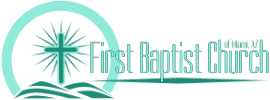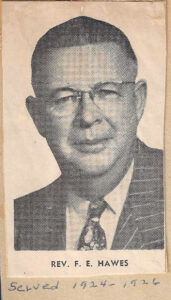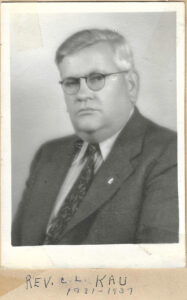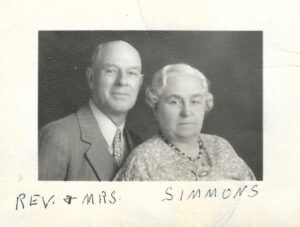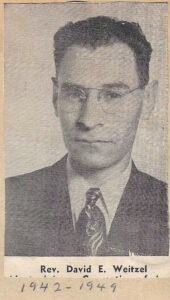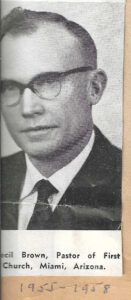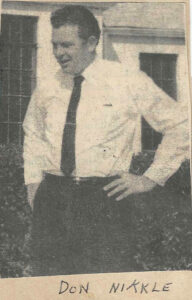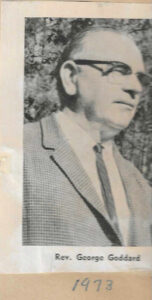History of First Baptist Church of Miami, AZ
Est. Easter, March 23rd, 1913
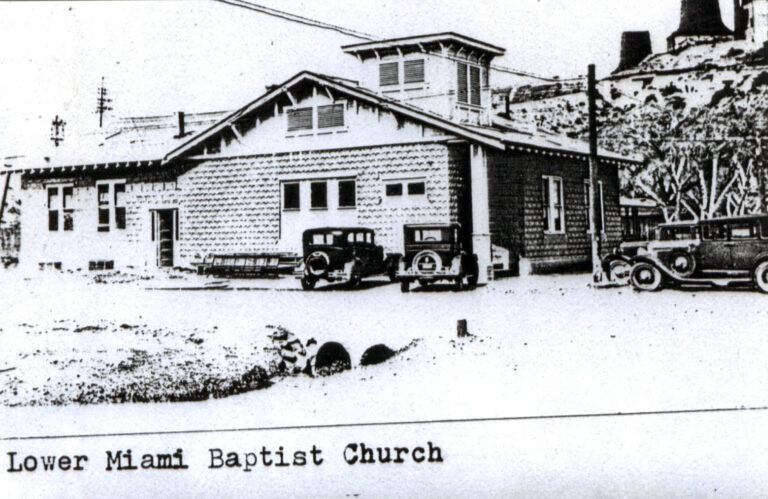
1912
In 1912, Miami, AZ, did not have a Baptist church. A Sunday School was started in Lower Miami School by Mr. and Mrs. Miles. A little later, the Home Mission Society sent Chapel Car Emmanuel under the leadership of Reverend E. R. Hermiston and his wife to serve the group of people.

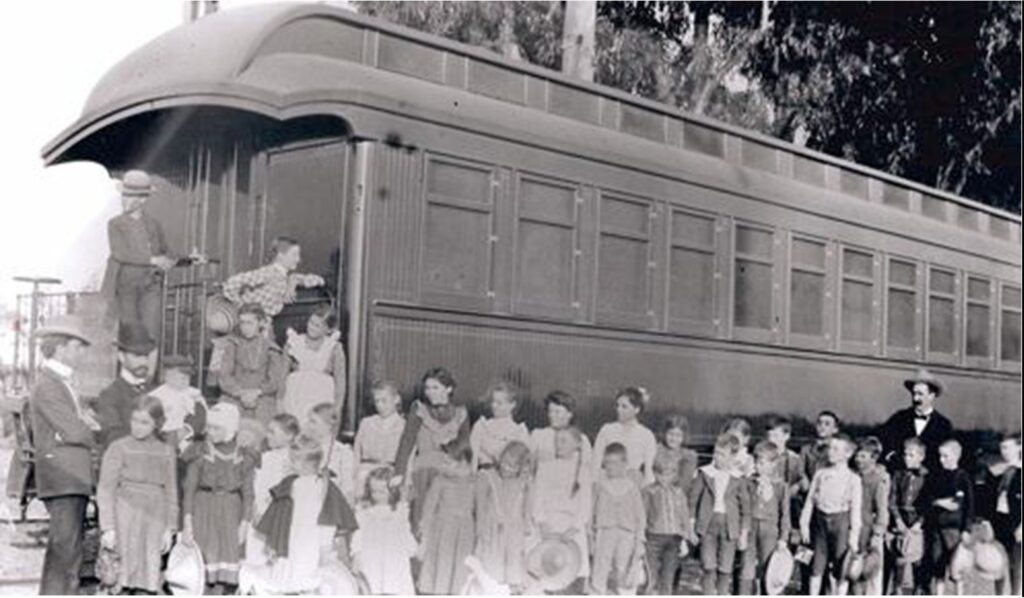
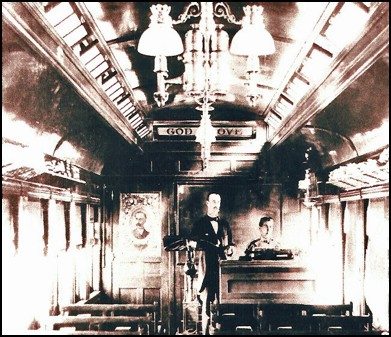
From the book This Train Is Bound for Glory, the Story of America’s Chapel Cars by Wilma Taylor and Norman Taylor, chapter 6:
Globe, sandwiched between the Apache and Pinal mountains, called itself the Capital City of the County with the Copper Bottom, although originally men came to mine silver not copper in its red mountains. In the early 1900s Globe was a wild west metropolis of twenty thousand boasting fifty dance halls and saloons that never closed. In one week, the operator of a North Broad Street soft drink stand witnessed three murders. Miners, from their new union hall, gaped while spreeing cowboys herded a wild-eyed steer through the plate glass window of a luxury gambling house, but in spite of the wildness, there were those in Globe who wanted more of a religious influence in town— they wanted a Baptist church.
The Globe Daily Silver Belt newspaper reported Sunday, December 1, 1912, that Reverend Hermiston preached in the morning and at the evening service. Mrs. Hermiston “delivered one of her best addresses “Mother, Home and Heaven” and Mr. Hermiston sang the beautiful solo, “Tell Mother I Will Be There.”
The following Sunday, the Hermistons followed a similar routine in services, and then the Silver Belt announced on December 11 that the couple were leaving Globe for other points in Arizona.
“The Silver Belt reported January 23, 1913, that the chapel car was now in Miami, where a church was under construction on land donated by Inspiration Copper Mining Company. The Miami Land and Improvement Company first developed Miami, founded in 1907, when they purchased a tract of land on the upper end of Miami Flats (where the down-town present day Miami is located).
In 1908 Cleve Van Dyke purchased the tract from the Miami Land and Improvement Company and also began purchasing adjacent tracts of land. It was not until two days after the first train arrived on the newly constructed railroad, 4th of October 1909 did the sale (and renting) of lots begin. At this point, the town was little more than an idea on paper. Only the roughest of streets had been graded, and no utilities of any kind were available.
Much progress had been made in the development of the Inspiration Company: construction of a mill and power plant, water supplies secured, one hundred employee houses, a lodging house and a boarding house provided, and there were doctors and a company hospital in town. A Presbyterian church had been started in 1911 in Miami, and the Baptists, who had been meeting in the schoolhouse, would boast the second church in town.
All the meetings were held in the car. A local journalist admired Mrs. Hermiston, who preached one evening on “Shall we know each other in Heaven.” “Mrs. Hermiston has contributed much toward the success of the meetings. She is a forceful and eloquent speaker and has been instrumental in the work of conversion. The car in which the services are conducted is arranged conveniently and is comfortable in every respect. The combination chapel and missionary car is novel in its self and an object of attraction.”
Just as Emmanuel was getting ready to leave the Globe/Miami area, the Presbyterians took up the revival spirit where the Baptists left off with another full week of evangelistic services. In this rich, open pit copper mine country, the devil was getting his due.
1913
Yet it was Rev. Lester Mathewson who officially organized the new Baptist Church in Lower Miami and became its first pastor in 1913. He was sent by the American Baptist Association (ABA). From the Arizona Silver Belt newspaper, December 18, 1915:

Rev. Lester B. Mathewson, pastor of the Miami Baptist Church, was transplanted from the narrow confines of the state of Rhode Island to the broad expanses of the state of Arizona. At first, he felt rather lost in Gila County, which is larger than his native state and still is only a small part of Arizona, but now he is entirely adjusted to his surroundings and is satisfied—thank you.
Mr. Mathewson was born near the city of Providence, Rhode Island. While he was yet a boy, the family moved into the city. Mr. Mathewson holds diplomas from the Providence grammar schools, the Classical High School, Brown University, and the Newton Theological Institution.
He finished his educational training with the distinction of not having failed in a single examination from the beginning to the end.
He entered Brown University in 1894 with the intention of studying to be a professor in advanced mathematics. At the close of his junior year, he felt the call to the ministry, so at his graduation in 1898, he entered the Newton Theological Institution near Boston, Mass.
In 1902, he went to southern California, where he lived until coming to Arizona in 1910. In 1910, he was called to be a pastor at Yuma, Arizona. He was pastor there for two years and in 1912 was sent to Miami to organize a church and erect a church building. Mr. Mathewson designed the building that now stands on the church property in Lower Miami. He superintended the construction and also did much of the work himself.
He also has a thriving out-station at Inspiration Comp, where he preaches every Thursday evening. The Bible School is held on Sunday afternoon.
The Lower Miami church will be dedicated tomorrow with appropriate ceremonies. Mr. Mathewson is distinctly a Miami booster. He is for a clean, united, thriving, large Miami, and is working constantly and consistently for these ends.
From the 1948 records of Rev. L. B. Mathewson, the founding pastor of First Baptist Church, he wrote:
In the late fall of 1912, I received instructions to go to Miami, AZ, and establish a church there. A few persons met in the schoolhouse to help plan erecting a church. In two or three weeks, I gathered with four Baptists and had a meeting. Mrs. Mathewson and I joined with four members to get a church lot and build a church on it that would be a credit to the community.
First, we secured a lot from the Inspiration Consolidated Copper Company, which they gave free of charge. When we saw the lot, we found that one side had a deep hole. We got a shovel, pick, and wheelbarrow and the four of us working together filled the hole and made the lot level.
Then we began to get money together for a building. We had no plans for a church that seemed to fit that place, so I designed one myself. First, there was the foundation to get ready. We did not have money to work with, so I had to do all the work I could myself. I dug most of the foundation excavation. We now needed rocks for the foundation and sand for the cement and blocks. Mr. Lane had a horse that he used to drive to work and told us that we could use it for a few days. We were able to buy a light wagon, and with the horse, we hauled 53 loads of rocks from land near the church site. I hauled a lot of sand too, and a boy named Hill who worked before school hours hauled sand for us too.
After the blocks were made and laid, several carpenters gave their time to build rafters on the roof. Then the man who laid the blocks helped me erect the roof boards and the roofing.
I did all the work on the church, laying the floor (carrying the lumber from the railroad a block away), putting the windows in, all the interior work, and painting, building the tower, filling gable ends. I even built the pulpit and pews for the choir.
What a happy time we had when the church was completed, and we had a pretty house in which to worship God and have a Sunday School.
Then we needed a parsonage. (The Mathewsons were living in a tent during this time.) With housing facilities extremely scarce, we were forced to borrow $50 from Mr. Hayes, a cattleman and father of Jess Hayes. With the money, we built a small house, 20×12 feet wide. In it, we constructed a kitchen, a two-foot-wide closet, a parlor, and a bedroom. Every morning, when we arose, we had to make up the bed and push it back to provide room to put on our clothes. But we soon moved from these cramped quarters and built a large house with money given to us by officials of the Inspiration Mining Company.

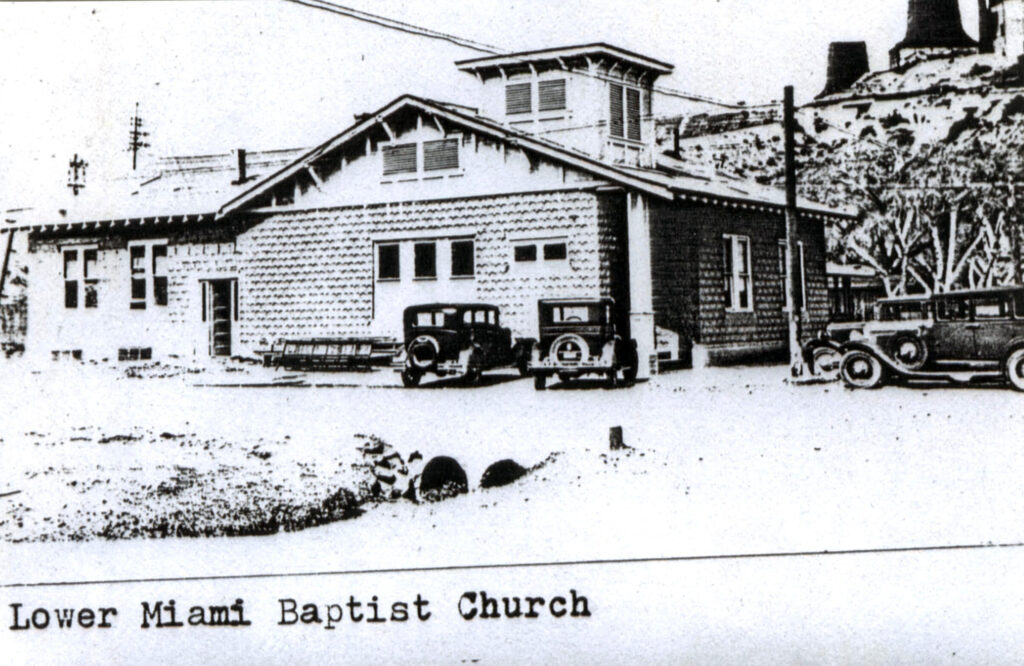
1927
On July 1st, 1927, the congregation voted to add to the church building an addition with Sunday School rooms and a basement with a kitchen. Pledges were taken and businesses were asked for donations. The teachers in the Primary department made apple pies and the children donated the apples. The Mission Society gave money for cement and for materials needed for finishing the inside. The women did quilting and held bazaars to raise money. They also had a cookbook printed and sold it to raise money.
1940
In 1940, another addition was built, containing two more Sunday School classrooms and a new baptistry. The Men’s Brotherhood sponsored this project and work was voluntary.
1953
Under the leadership of Pastor Lyman Norris, the church had grown to the point where they needed a new sanctuary. The first bond to build a new sanctuary was purchased in August of 1953. Some individuals purchased bonds and many were bought from the general fund. The building committee was composed of Mr. G. Dewey Creasman, Mr. J. S. Miller, and Mrs. Tracy Simmons. They enlisted pledges and promises of volunteer labor.
A loan of $20,000 was secured from the Home Mission Society, and Mrs. Davis gave the lot for the building. On November 6, 1953, the building contract was signed with the Homes and Sons of Phoenix. Work started immediately on the new sanctuary which had been designed by Mr. Robert Theodosis, husband of Ruthe Crowe Theodosis, a former member. Work progressed satisfactorily with the help of many “sidewalk superintendents.”
On Easter Sunday morning, April 8, 1954, the first service was held in the beautiful new building, something that members had waited, hoped, and prayed for. Dedication services were held on May 16, 1954.
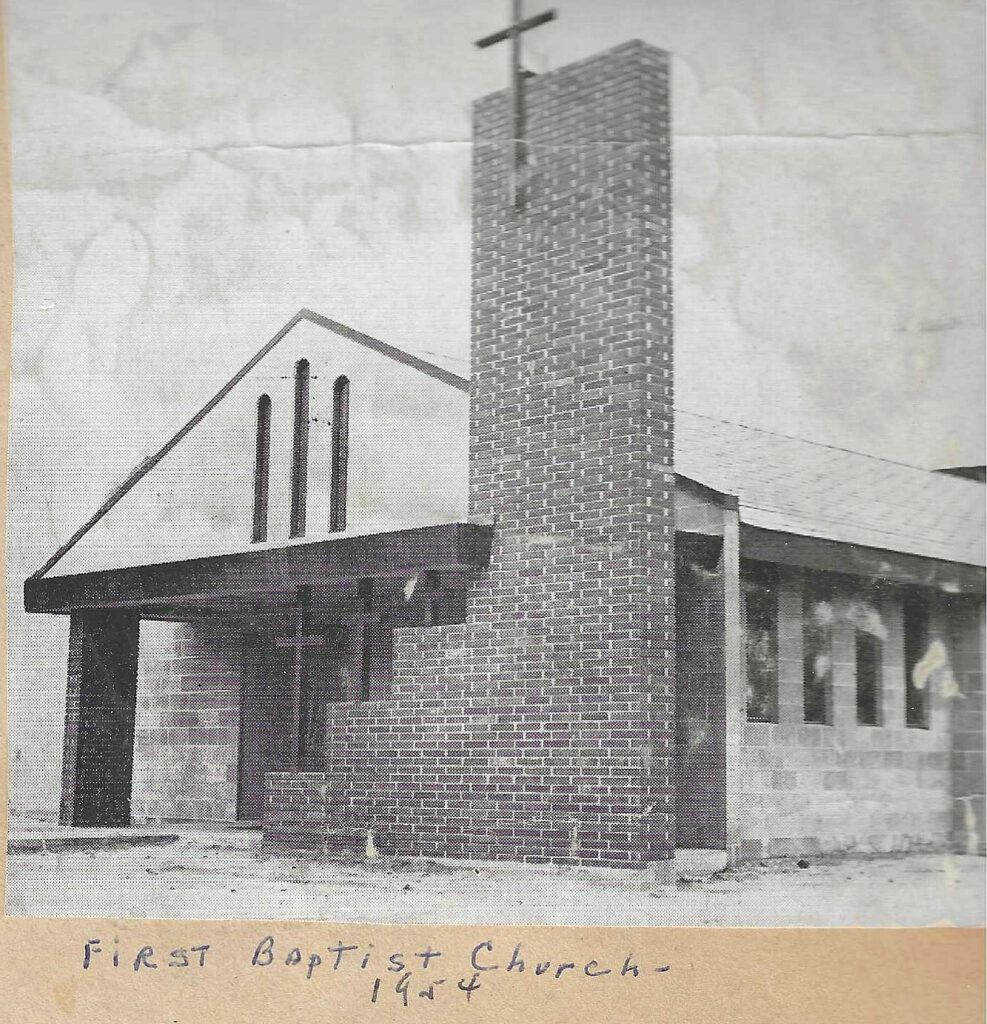
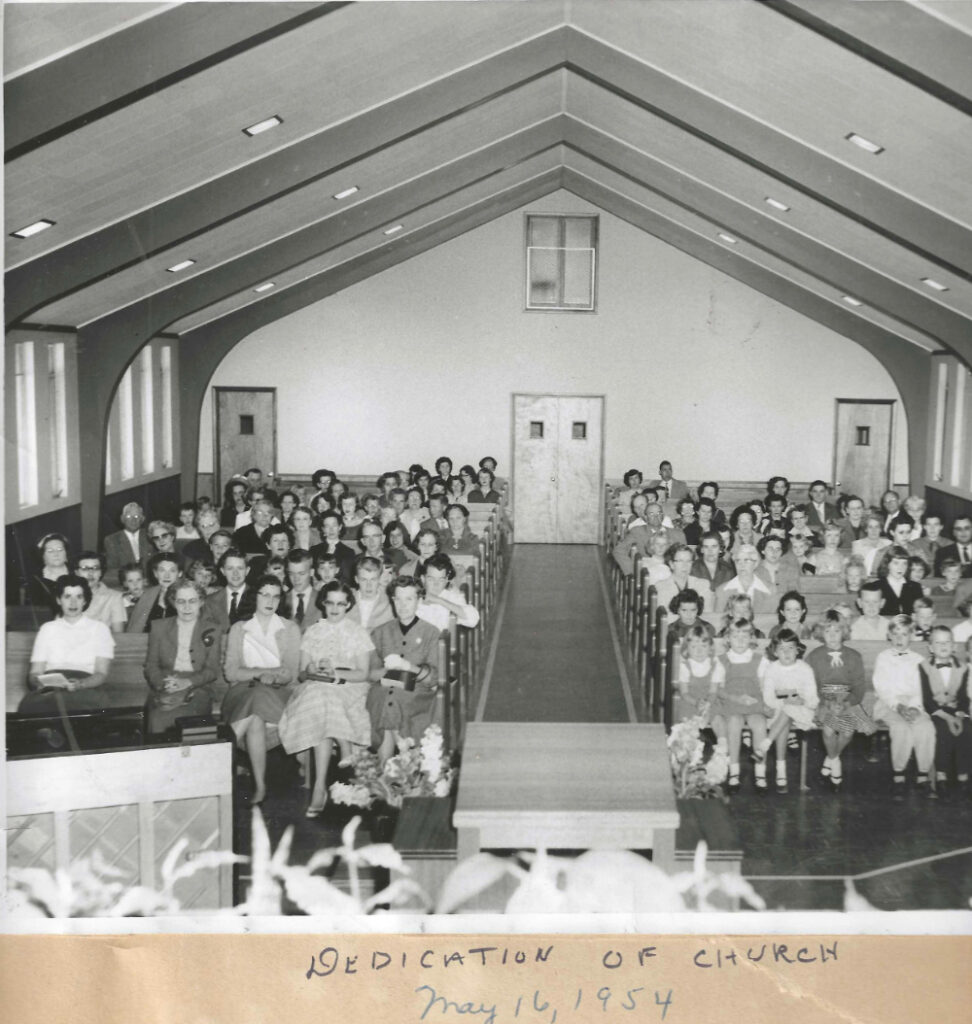
1957
The church purchased the G. D. Creasman home in 1957 for use as a parsonage, and the former parsonage was used as part of the educational plant.
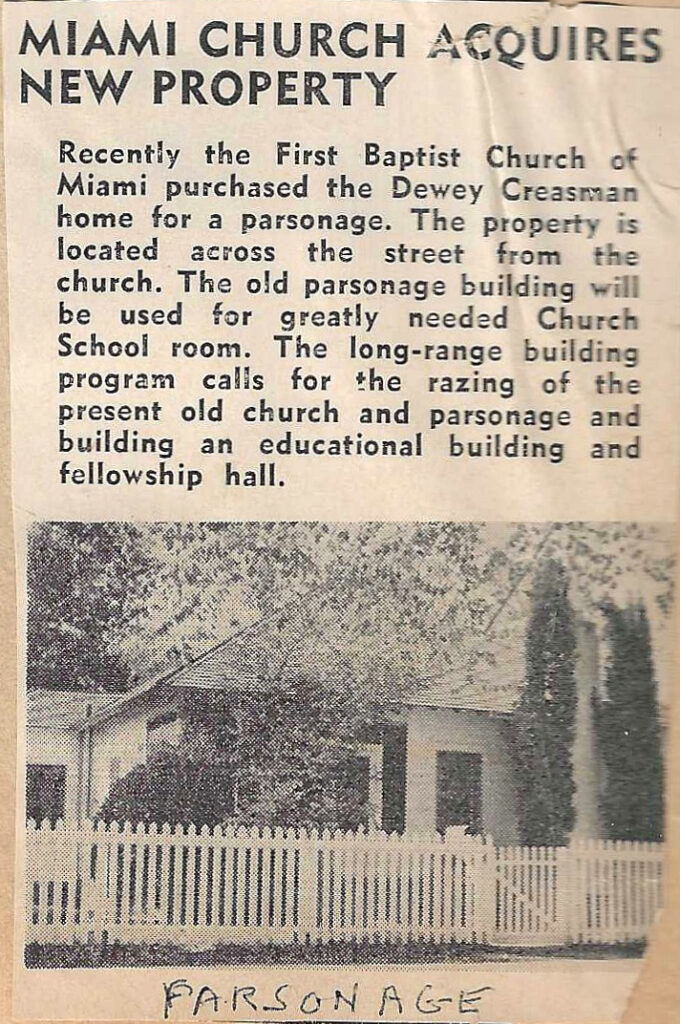
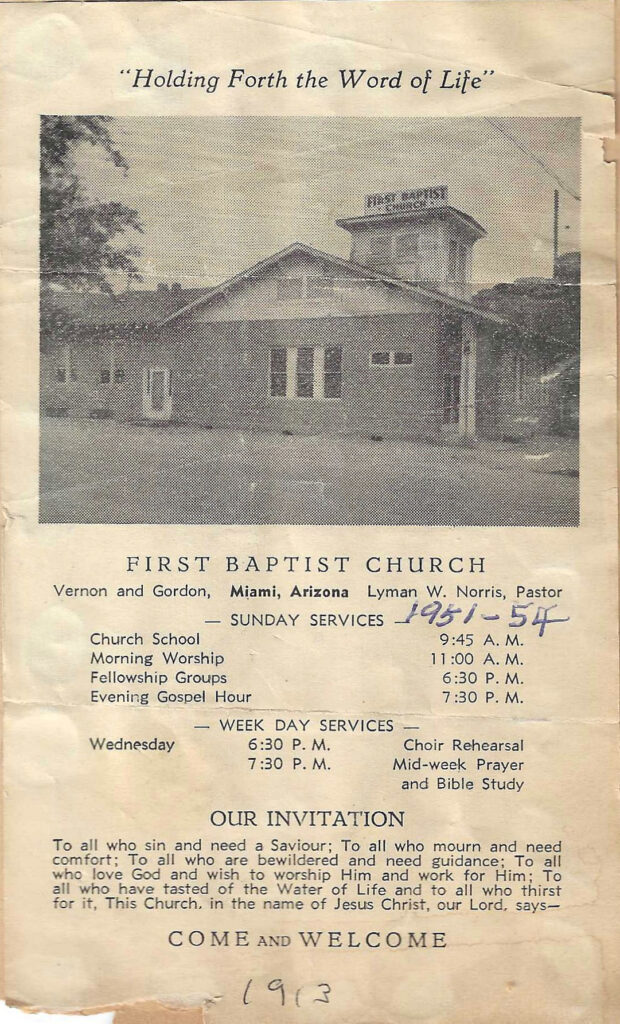
1959
On December 20, 1959, there was a special service in the sanctuary with Dr. Carlton W. Saywell and the board of trustees in charge. The mortgage was burned, showing that the new sanctuary was completely paid for. The pastor, Rev. Everett Berrey, and the deacons dedicated the piano and Hammond organ at this service also.
1963
At the 50th anniversary observance on March 31, 1963, many former members gathered with the congregation to give thanks and to reminisce. The morning sermon was preached by Dr. Carlton W. Saywell. Honored guests were two charter members of the church: Mrs. Dalton Davis and Mrs. Frank Lucas, the only two still in Miami at the time.
2002
In the early 2000s, under Pastor Sam Yingling, the church broke away from the American Baptist Association and became independent, since, at that time, the ABA was not involved in the administration of FBC and the members felt largely forgotten by the ABA. This independence granted the congregation more flexibility to serve God, to reach the community, and to use all the given tithes and offerings as God led the pastor and congregation.
2024
By January of 2024, FBC had experienced a number of highs and lows, but the church was at a low point with an attendance of around 15 to 20 people. The congregation had been without a permanent pastor for over 14 months and was hanging on only by the prayers and sheer determination of a few remaining members and the help of Interim Pastor Steve Prickett.
Pastor Greg S. Baker officially became the pastor of FBC on February 10th, 2024, called by God to reenter the ministry and to serve the communities of Globe and Miami. With the help of God and the dedicated membership of FBC, the church has begun to grow under Pastor Baker’s leadership, with a high attendance of 98 in 2024. Over 77 people trusted Jesus as their Savior that year and 12 were baptized!
First Baptist Church wishes to honor the long history of the church and those who sacrificed, prayed, and worked to keep the church as a light of the Gospel of Jesus Christ.
Deuteronomy 32:7 – Remember the days of old, consider the years of many generations: ask thy father, and he will shew thee; thy elders, and they will tell thee.
All glory belongs to our God and to our Savior, Jesus Christ.
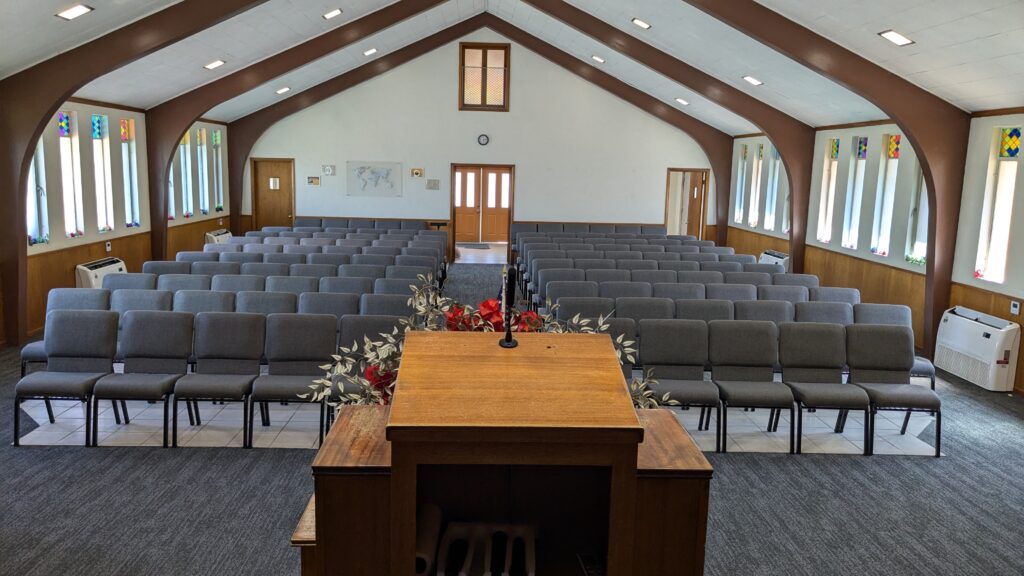
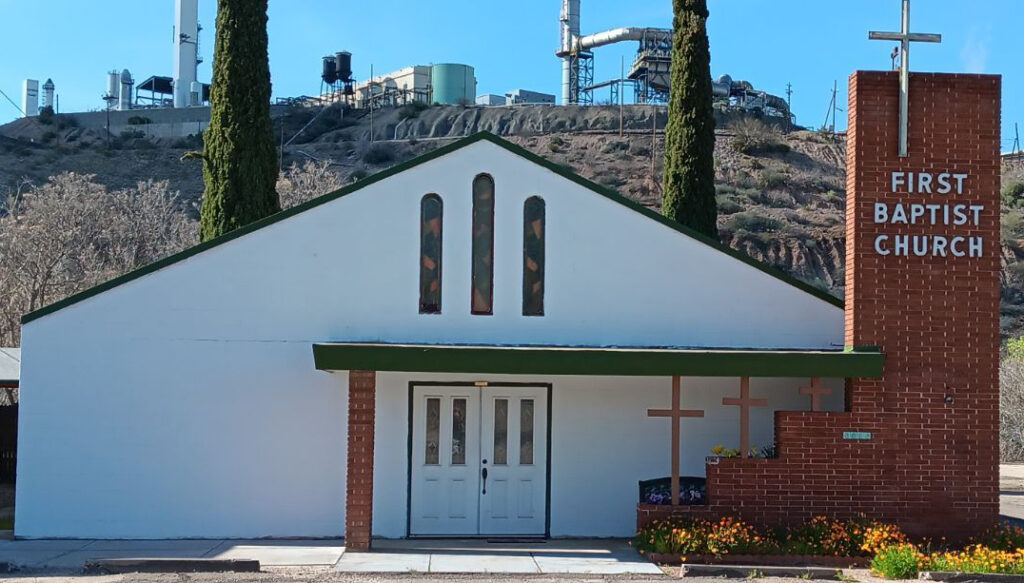

Known Pastors Who Served First Baptist Church
- Lester B. Mathewson: 1913-1917
- Mr. Lawrence: 1918
- A. Parker: November 1919 – April 1920
- E. Summers: August 1920 – October 1921
- Tallie Williams: March 1922 – August 1922
- Lawerence Bell: May 1923 – August 1924 (jointly with Globe Church)
- E. Hawes: 1924 – June 1926
- Paul Smith: Summer months of 1926
- Clyde Brengle: September 1926 – November 1930
- Charles L. Kau: March 1930 – September 1937
- L. Simmons: 1937 – May 1942
- David Weitzel: July 1942 – February 1949
- Walter Sadler: July 1949 – December 1950
- Lyman Norris: March 1951 – November 1954
- Cecil Brown: January 1955 – December 1958
- W. C. Barclay: February – April 1959
- E. Berrey: July 1959 – 1963
- Donald T. Nikkel August 1963 – August 1966
- Mr. Simpson (interim pastor): September 1966 – June 1967
- George Goddard: June 1967 – December 1973
- Glen Peak: February 1974 – August 1976
- Frank Arnel: 1978
—Nearly 20 Year Gap in Records—
- William Greer: 1995 – 2001
- Sam Yingling: 2001 – 2004
- Jack Lamb: 2004 – 2012
- Derek Wheeland: 2012 – June 2021
- Steve Prickett (interim pastor): 2023 – January 2024
- Greg S. Baker: February 2024 – to Present
